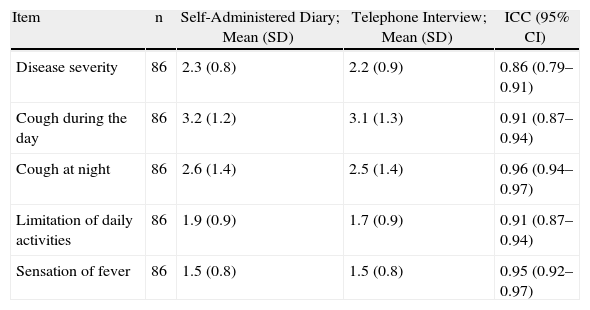Acute bronchitis is a very prevalent entity in primary care, representing approximately 10% of all infections that family physicians treat in their consultations.1 Cough is its main symptom, which persists between 10 and 20 days in acute uncomplicated bronchitis in a patient without chronic obstructive pulmonary disease, although it may sometimes persist up to 4 weeks. To date, few studies have been done using diaries in order to know the duration of the symptoms. In a recently published study, it was observed with a 14-item diary that the average time it took for the patient to score 0 in all the symptoms was 22 days.2 In this case, a 6-symptoms diary was used, in which the patients scored their state on a 7-point scale. Other studies have used questionnaires filled out by health-care professionals. The most widely known is the Bronchitis Symptom Score, which uses 5 characteristics (cough, sputum, wheezing/crackles, chest pain and dyspnea).3 However, this diary cannot be filled in by the patient him/herself. On the other hand, the fundamental limitation of self-administered symptoms diaries is that, generally, they are not properly completed because they either have many questions or are difficult to understand.
A recent study has been published which used a short diary of symptoms, known as the Acute Bronchitis Severity Score (ABSS).4 This diary keeps track of 5 symptoms: severity of the disease (very mild, mild, moderate, severe and very severe), cough during the day (0–2 times, 3–5 times, 6–10 times, 11–20 times and more than 20 times), cough at night (same as before), limitation of daily activities (none, mild, moderate, severe and very severe) and sensation of fever (none, mild, moderate, severe and very severe). The original English version was validated in 2007.5 In this study, our objective was to know the reliability of the Spanish version of this diary. In order to do so, this present study took place in a health-care center where the patients who participated had been diagnosed with uncomplicated acute bronchitis with purulent expectoration. The patients were given symptoms diaries, and we explained how to fill them out and recommended them to be completed every evening before going to bed. The Spanish version of the ABSS was derived from the translation and reverse translation of the original English scale. Before the patients turned in the completed diaries, we called them on the phone to ask them the same questions while the patient was not looking at the diary (test–retest). The study was approved by the Ethics Committee of the Fundació d’Atenció Primària Jordi Gol i Gurina. The internal consistency was analyzed with Cronbach's α coefficient, which takes values between 0 and 1, and which was used to evaluate the homogeneity of the different items in the diary. Furthermore, the stability over time was analyzed with the test–retest reliability analysis for each of the items written down in the diary by the patient and those recorded by the physician during the phone interview. For this analysis, the intraclass correlation coefficient (ICC) was used, with values ranging between 0 (lack of agreement between measurements) and 1 (perfect agreement). The upper and lower limits were calculated with their 95% confidence intervals.
We recruited 86 consecutive patients. Mean age was 52.4 (6.3), and 54.7% were women. Most telephone calls were done on the third day (38 cases, 44.2%), with a range from days 1 to 22. The internal consistency analysis presented a Cronbach's α of 0.79 and no items increased the α when it was extracted from the scale. As for the stability over time in a qualitative scale, the ICC for the 5 items were either good (for disease severity) or very good (for the remaining questions) (Table 1), as in this last group the ICC were higher than 90%.6 The homogeneity or internal consistency of the scale can be considered good: Cronbach's α was almost 0.8, and it was observed that all the items contributed to improve this coefficient. The next step would be to carry out a validation study of the diary and study whether this instrument is able to discriminate between individuals with different degrees of severity, although in this pathology there is no accepted reference pattern with which the responses of the diary could be compared. In any event, this study suggests that the use of the Spanish version of the ABSS symptoms diary is reliable in acute bronchitis.
Results of the Questions of the Symptom Diary and Reliability.
| Item | n | Self-Administered Diary; Mean (SD) | Telephone Interview; Mean (SD) | ICC (95% CI) |
| Disease severity | 86 | 2.3 (0.8) | 2.2 (0.9) | 0.86 (0.79–0.91) |
| Cough during the day | 86 | 3.2 (1.2) | 3.1 (1.3) | 0.91 (0.87–0.94) |
| Cough at night | 86 | 2.6 (1.4) | 2.5 (1.4) | 0.96 (0.94–0.97) |
| Limitation of daily activities | 86 | 1.9 (0.9) | 1.7 (0.9) | 0.91 (0.87–0.94) |
| Sensation of fever | 86 | 1.5 (0.8) | 1.5 (0.8) | 0.95 (0.92–0.97) |
n: number of cases; SD: standard deviation; ICC: intraclass correlation coefficient; CI: confidence interval.
Please cite this article as: Moragas A, et al. Fiabilidad de un diario de síntomas autoadministrado para evaluar la evolución de la bronquitis aguda. Arch Bronconeumol. 2012;48:261–2.











